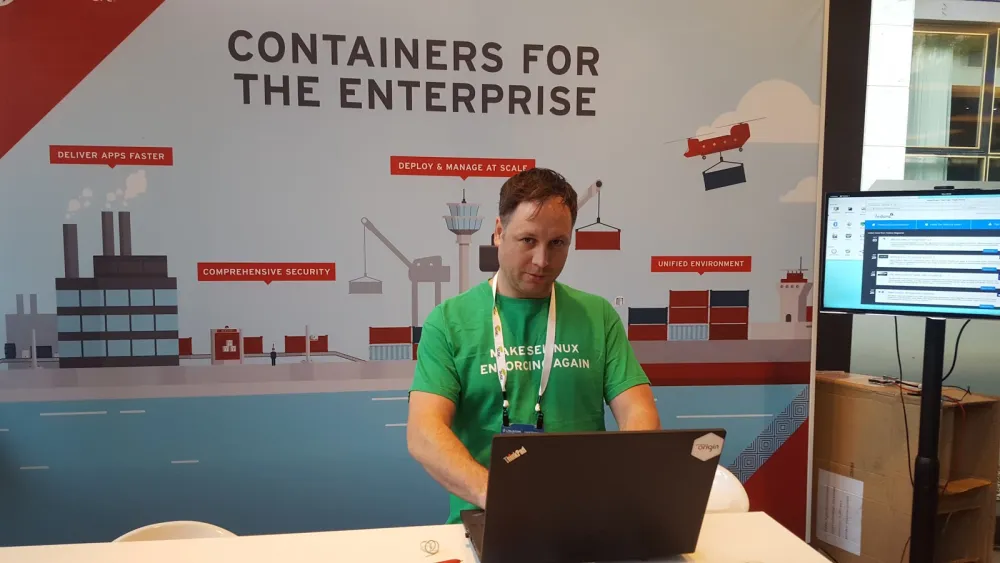Linux containers, and their use in the enterprise, are evolving rapidly. If I didn't know this already, what I'm seeing at conferences like ContainerCon would confirm it. We've moved on from "what are containers, anyway?" to "let's hunker down and get it right."
Recently, I attended and spoke at LinuxCon/ContainerCon Europe. Like LinuxCon/ContainerCon North America, many of the keynotes touched on Linux container work going on in the community. At the European edition there was a particularly strong focus on Linux container security and networking. At least six sessions were focused on kernel security, orchestration security, and general container security. Four talks focused on container networking. Along with container security and networking, there were a lot of sessions about cloud native and containerized applications.
Containers have brought attention back to Linux which makes LinuxCon/ContainerCon a fitting place to talk about containers. One of the most interesting observations was that many, many attendees had questions about how to build, secure, and populate (i.e. build containers) a containerized infrastructure and they all required knowledge of the Linux kernel or the Linux user space. After 25 years of Linux, we are going through a quickening again. Linux Containers have brought a renewed focus on the operating system, and that’s exciting for an old curmudgeon like me!
Interesting Talks
Here are some of the talks that I attended and gave. You will notice a focus around people, processes, and tools related to containers, container infrastructure, and container security:
- Taming Container Fears
- Container Defense in Depth
- Containers for Grownups: Migrating Existing & Traditional Applications
- Dev and Ops: Collaborating on an Up-to-Date Build Chain
- Linux Kernel Security Update
Conversations
After my talks we kicked up some really good conversations about how to put real life applications in containers and how to secure them. A general theme that kept coming up is that containers are just specialized processes, so think about them similarly to regular processes when thinking about how to manage DR, backup, isolation, tenancy, etc.
On the other hand, a lot of things are different with containers, but they require a fundamental understanding of how operating systems work to feel confident about making architectural decisions. An application architect needs to understand how to split up the code, configuration, and data. It’s also important to go back to Unix processes 101 and understand when to split your application into multiple containers.
If you are interested in a deeper understanding of the architectural changes necessary to migrate applications to containers or build container native, check out Containers for Grownups: Migrating Existing & Traditional Applications. If you are interested in understanding the Linux kernel and user space, check out the Architecting Containers series.
Conclusion
Containers are all the rage - but you knew that already. What’s of note is that community members, customers, and thought leaders are all working hard to architect and build the next generation of infrastructure based on Linux containers. I think it’s important to remember that containers are basically fancy Linux processes, so a lot of what our architect brains already know about Linux can be leveraged with containers.
The hot topics were container networking, container security, migrating applications to containers and building cloud native applications with containers.
Celebrating 25 years has been fun and here’s to 25 more with Linux Containers. As always, leave comments, questions, and shout-outs below!
Sull'autore
Altri risultati simili a questo
Slash VM provisioning time on Red Hat Openshift Virtualization using Red Hat Ansible Automation Platform
Red Hat Ansible Automation Platform: Measuring Business Impact with Dashboard and Analytics
Technically Speaking | Platform engineering for AI agents
Technically Speaking | Driving healthcare discoveries with AI
Ricerca per canale
Automazione
Novità sull'automazione IT di tecnologie, team e ambienti
Intelligenza artificiale
Aggiornamenti sulle piattaforme che consentono alle aziende di eseguire carichi di lavoro IA ovunque
Hybrid cloud open source
Scopri come affrontare il futuro in modo più agile grazie al cloud ibrido
Sicurezza
Le ultime novità sulle nostre soluzioni per ridurre i rischi nelle tecnologie e negli ambienti
Edge computing
Aggiornamenti sulle piattaforme che semplificano l'operatività edge
Infrastruttura
Le ultime novità sulla piattaforma Linux aziendale leader a livello mondiale
Applicazioni
Approfondimenti sulle nostre soluzioni alle sfide applicative più difficili
Virtualizzazione
Il futuro della virtualizzazione negli ambienti aziendali per i carichi di lavoro on premise o nel cloud

